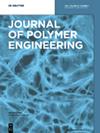苯胺氧化催化聚合表面改性聚砜超滤膜的分离特性
IF 1.2
4区 材料科学
Q4 POLYMER SCIENCE
引用次数: 0
摘要
采用不同的氧化催化剂(FeCl3、CuCl2和APS)对市售聚砜(PSF)膜表面进行了苯胺溶液聚合改性。然后对改性膜的理化性质进行表征,如表面化学、孔隙度、润湿性、表面粗糙度、形貌等。观察到,聚苯胺对膜进行表面改性后,膜的亲水性/润湿性增加,这又取决于所使用的氧化催化剂的性质。使用FeCl3和CuCl2作为氧化剂的膜表现出更好的渗透、蛋白质排斥和防污性能,而使用APS作为氧化剂的膜性能则有所下降。在所有改性膜中,PSF/PANI-CuCl2膜表现出较高的纯水通量和蛋白溶液渗透通量,分别为453.3 L/m2.h和122.3 L/m2.h。与其他改性膜相比,PSF/PANI-CuCl2膜具有更好的抗生物污染能力。利用ATR、XPS、FESEM、AFM等分析技术对改性膜进行表征。接触角测量也支持PSF/PANI-CuCl2膜与聚砜膜表面具有更好的化学和生理附着力。本文章由计算机程序翻译,如有差异,请以英文原文为准。
Separation Characteristics of Surface Modified Polysulfone Ultrafiltration Membrane using Oxidative Catalytic Polymerization of Aniline
The commercially available Polysulfone (PSF) membrane surface was modified by solution polymerization of aniline using different oxidation catalysts i.e., FeCl3, CuCl2, and APS. Modified membranes were then characterized with respect to physio-chemical properties like surface chemistry, porosity, wettability, surface roughness, morphology, etc. It was observed that the hydrophilicity/ wettability of membranes was increased upon surface modification by polyaniline which again depended on the nature of the oxidation catalyst used. Membranes developed using FeCl3 and CuCl2 as oxidants exhibit improved permeation, protein rejection, and antifouling properties, whereas decrement was observed in modified membrane performance using APS as an oxidant. Among all modified membranes, PSF/PANI-CuCl2 membrane demonstrates the most promising performance in terms of higher pure water flux and protein solution permeation flux i.e., 453.3 L/m2.h and 122.3 L/m2.h respectively. The PSF/PANI-CuCl2 membrane unveils superior resistance towards bio-fouling in comparison to the other modified membranes. Analytical techniques were used for the characterization of the modified membranes such as ATR, XPS, FESEM, and AFM. Contact angle measurement also supports the fact that PSF/PANI-CuCl2 membrane has a better chemical and physiological attachment to the polysulfone membrane surface.
求助全文
通过发布文献求助,成功后即可免费获取论文全文。
去求助
来源期刊

Journal of Polymer Materials
工程技术-高分子科学
CiteScore
1.00
自引率
0.00%
发文量
27
审稿时长
4.7 months
期刊介绍:
Journal of Polymer Materials-An International Journal is published quarterly (4 issues per year), which covers broadly most of the important and fundamental areas of Polymer Science and Technology. It reports reviews on current topics and original research results on synthesis of monomers and polymers, polymer analysis, characterization and testing, properties of polymers, structure-property relation, polymer processing and fabrication, and polymer applications. Research and development activities on functional polymers, polymer blends and alloys, composites and nanocomposites, paints and surface coatings, rubbers and elastomeric materials, and adhesives are also published.
 求助内容:
求助内容: 应助结果提醒方式:
应助结果提醒方式:


